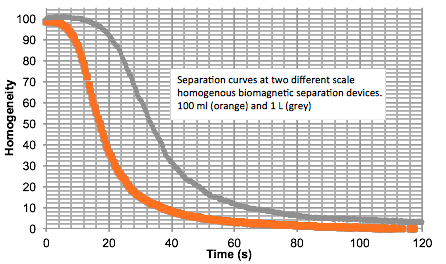The concentration of magnetic beads is an important step in a magnetic separation process. Separation time is dependent on magnetic bead concentration, and final kit performance is also very dependent on accurate concentrating techniques, but liquid handling inaccuracies can lead to serious errors. If these concentration errors are not detected early in the process, excessive time, money and effort will need to be spent to either correct or redo the batch.
This post is about biomagnetic separation in the production of magnetic beads for IVD kits. If you want to know its most important elements, download our free ebook The basic guide to use biomagnetic separation in production processes:
The correct concentration of functionalized magnetic beads is very important for final kit performance (e.g. in immunoassay kits or molecular diagnostic kits). Liquid handling, especially in large volumes, can be very tricky – even a graduated cylinder has a precision of only 2% or less. Therefore, even with strict observance of SOPs, the concentration can be variable, especially when the process involves many buffer changes.
For well-defined homogenous biomagnetic separation processes, the behavior of the process will be dependent on the concentration of beads. Higher concentrations of beads result in a shorter separation time (approximately as the fourth root). This relationship is explained by the collective nature of bead movement. The closer the beads are to one another (higher concentration), the easier they form long, fast-moving chains.
Advanced optical monitoring for critical error detection
Advanced optical monitoring of homogenous biomagnetic separation processes, for example using SEPMAG’s QCR system, can help to detect concentration errors. For example, a 10% change in concentration will modify the separation time by 2.6%. When one compares the current batch curve with a standard curve, it will typically show a shorter half-width time (t50) and steeper change in behavior if the concentration is higher than the specifications. Alternatively, the change in behavior will be smoother and the t50 larger if the suspension is more dilute than the specifications.
Concentration errors can be readily and uniquely detected apart from other sources of errors by optically monitoring the process. The errant batch can be stopped shortly after the magnetic separation step and technicians can take corrective action early or start a new lot, saving time, energy and money.
If you found this post about using biomagnetic separation for production useful, don't forget to check these related posts:
- Perfecting the magnetic separation process in magnetic bead IVD kit production
- Issues with magnetic beads lot-to-lot inconsistent properties
- How concentration changes affect Biomagnetic Separation
Check www.sepmag.eu/ebooks to access to FREE eBooks on the subject, or contact us. We will be glad to help you to achieve an efficient magnetic bead separation process!





